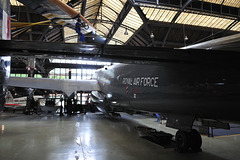Phil's photos with the keyword: Military
York castle (Clifford's tower).
| 03 Jun 2013 |
|
|
|
The now-ruinous keep of the medieval Norman castle is commonly referred to as Clifford's Tower. Built originally on the orders of William I to dominate the former Viking city of York, the castle suffered a tumultuous early history before developing into a major fortification with extensive water defences. After a major explosion in 1684 rendered the remaining military defences uninhabitable, York Castle continued to be used as a prison until 1929.
(Wikipedia).
www.ipernity.com/group/england
www.ipernity.com/group/history</a
RAF Shackleton.
| 23 Jul 2015 |
|
|
|
The Avro Shackleton was a British long-range maritime patrol aircraft, used by the Royal Air Force and the South African Air Force. It was developed by Avro from the Lincoln bomber, itself being a development of the famous wartime Lancaster bomber of "Dambusters" fame. Entering service with the RAF in 1951, the Shackleton was used in anti-submarine warfare and maritime patrol aircraft roles; it was also used as a search and rescue platform and performed several other roles such as troop-transport. In later life a small number of the RAF's Shackletons were subsequently adapted for airborne early warning duties, performing in this capacity until the type's retirement in 1991. The type is named after the polar explorer Sir Ernest Shackleton.
Photographed at the Museum Of Science and Industry (M.O.S.I.) in Manchester, North-West England.
Camera: Nikon D300s
Lens: Nikkor 17-55mm f2.8
Processed with Nikon Capture NX2
Lightning P.1A prototype.
| 23 Jul 2015 |
|
|
|
An experimental P1A prototype supersonic interceptor aircraft which eventually became the English Electric / British Aircraft Corporation "Lightning". Photographed at the Museum Of Science and Industry (M.O.S.I.) in Manchester, North-West England.
"The official ceiling of the Lightning was secret. In 1962 Fighter Command organised interception trials on Lockheed U-2s at heights of around 60,000–65,000 ft. In order to avoid risking the U-2 the Lightning was not permitted closer than 5,000 ft and could not fly in front of the U-2. The sorties proved that successful intercepts could be made at up to 65,000 ft. In 1984 during a NATO exercise, Flight Lieutenant Mike Hale intercepted a U-2 at a height which they had considered to be safe (thought to be 66,000 feet). Records show that Hale climbed to 88,000 ft in his Lightning".
(Wikipedia....shortened & edited)
Camera: Nikon D300s
Lens: Nikkor 17-55mm f2.8
Processed with Nikon Capture NX2
More Information here:
en.wikipedia.org/wiki/English_Electric_Lightning
RAF Belvedere helicopter.
| 22 Jul 2015 |
|
|
|
The Bristol Type -192 Belvedere was a British twin-engine, tandem rotor military helicopter built by the Bristol Aeroplane Company. It was designed for a variety of transport roles including troop transport, supply dropping and casualty evacuation. It was operated by the Royal Air Force (RAF) from 1961 to 1969. The Belvedere was based on the Bristol Type -173 10-seat (later 16-seat) civilian helicopter which first flew on 3rd January 1952.
Photographed in Manchester, North-West England, at the Museum Of Science and Industry (M.O.S.I.).
Camera: Nikon D300s
Lens: Nikkor 17-55mm f2.8
Processed with Nikon Capture NX2.
Avro 707A experimental aircraft.
| 22 Jul 2015 |
|
|
|
The Avro 707 was a British experimental aircraft which first flew in 1949. It was built to test the tailless, thick delta wing configuration chosen for the Avro 698 jet bomber, later named "Vulcan". Aerodynamically, the Avro 707 was a 1/3 - scale version of the famous Vulcan "V bomber" and it continued to be used for other research both in the UK and Australia until it was "retired" in 1967.
Photographed at the Museum Of Science and Industry (M.O.S.I.) in Manchester, North-West England.
Camera: Nikon D300s
Lens: Nikkor 17-55mm f2.8
Prcessed with Nikon Capture NX2
Kamikaze.
| 22 Jul 2015 |
|
|
|
The Yokosuka MXY-7 Ohka ("cherry blossom") was a purpose-built kamikaze aircraft employed by the Imperial Japanese Navy Air Service towards the end of World War II. It was a small flying bomb that was carried underneath a bomber to within range of its target. On release, the pilot would first glide towards the target and when close enough he would fire the Ohka 's rocket-powered engine and dive against the target ship to destroy it. The final approach was almost unstoppable because the aircraft gained tremendous speed.
Photographed at M.O.S.I. (Museum Of Science and Industry) in the city of Manchester, North-West England.
Camera: Nikon D300s
Lens: Nikkor 17-55mm f2.8
Processed with Nikon Capture NX2
Jump to top
RSS feed- Phil's latest photos with "Military" - Photos
- ipernity © 2007-2025
- Help & Contact
|
Club news
|
About ipernity
|
History |
ipernity Club & Prices |
Guide of good conduct
Donate | Group guidelines | Privacy policy | Terms of use | Statutes | In memoria -
Facebook
Twitter






